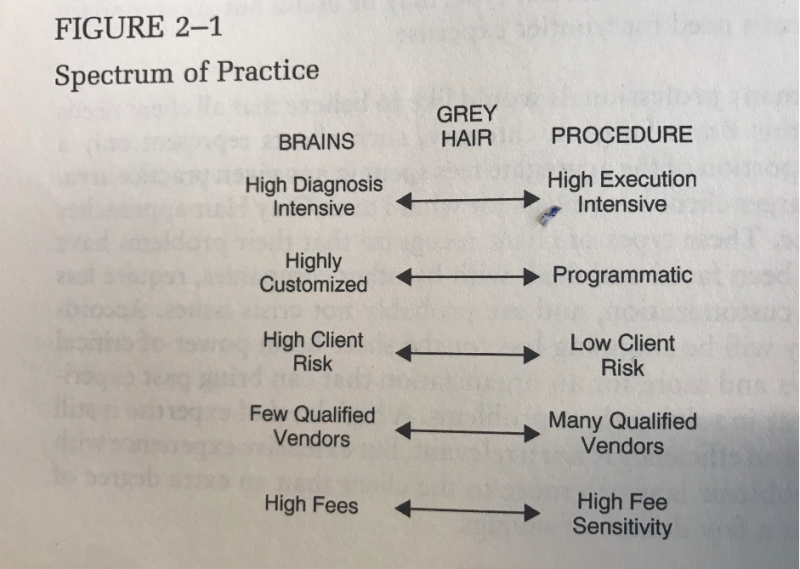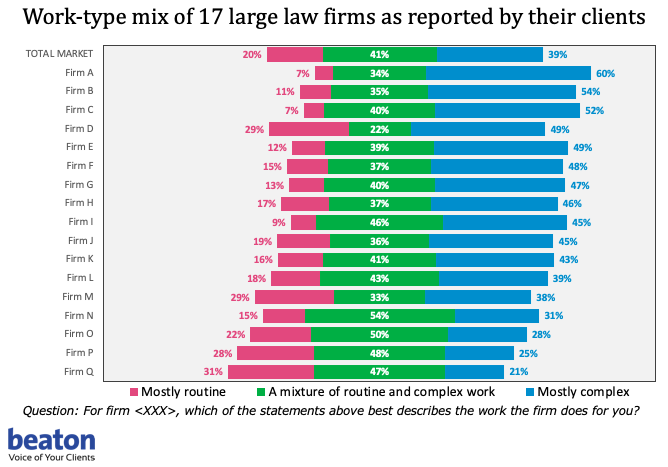It’s 25 years since David Maister published Managing the Professional Service Firm (1993) and his insights live on.
Recently, while preparing a presentation to professional services CMOs, we dipped into chapter 2, ‘The Professional Firm Lifecycle’ and were reminded of the depth of David’s prescience on how meeting the range of clients’ needs profitably requires different business models.



Figure 2-1 in Managing the Professional Service Firm shows David’s original classification of work types.
He colourfully described a spectrum ranging from brain surgery (the most complex, mission-critical work requiring specialised Expertise) through grey hair (requiring lots of Experience) to routinised, procedural work (Efficiency). The 3Es is our mnemonic.
We can now report that beaton, using our tracking dataset of hundreds of thoughts of individual pieces of client feedback, has produced what as far as we know is the first empirical and detailed evidence that clients of BigLaw firms see work types the same way as David first did.



As the chart shows, the work type mix for 17 large corporate and commercial Australian law firms – as perceived and reported by their clients – separates one firm from another. For example, firms A, F, G and I are generally agreed to be in the same strategic group, yet there’s considerable variation in their clients’ perceptions of work type mix.
We also have this data for the accounting and consulting engineering professions and amongst our reports, whre these insights are reflected with some profession nuances.
Our dataset also contains confirmatry data for the ideas expressed in Figure 2-1 of Maister’s seminal work:
- What clients are looking for varies based on work-type, for example, complex work clients are more likely to be swayed by a firm’s expertise in their area of need whereas routine work clients are more interested in ease of doing business when choosing a firm;
- These are distinct markets with different competitive dynamics: the top three performers for routine work are not the same as the top performers for complex work; and
- While top performing complex work firms all have price-setting discretion and latitude to charge premium pricing, those same firms are perceived to charge more than fair value for routine work.
Implications for you
These findings confirm Maister’s original 3Es framework. The implications are far-ranging:
- Different work types require different business models, including how work is won (marketing and BD), how work is delivered (staffing, sourcing, processes, role of technology), how work is priced, and how productivity and profitability are measured and rewarded.
- In turn, these differences mean different cultures and leadership styles are required to align strategy, structure, systems and people with clients and their needs.
- And further, the optimum ownership, capital structure and governance requirements of complex and routine work providers differ substantially.
To quote David Maister in 1993 “The degree to which professional marketplaces have already recognised and embodied the overwhelming differences between expertise, experience and efficiency practices varies significantly” and “The conflicting economic, behavioral, and managerial requirements of different practice areas are sufficiently great to cause create severe internal tensions and stress as firms struggle to establish firm-wide management philosophies to accommodate these diverse needs.”
25 years on, one has to ask, “Just how far have BigLaw firms come in managing their work type portfolios?” For the majority, I would say, “Not very far”.
When seeking a portfolio of strategic work types, firms need to ensure there is alignment in the business and operating models of their complex and routine work.
The corresponding post type is disabled. Please make sure to 1) install The7 Elements plugin under The7 > Plugins and 2) enable desired post types under The7 > My The7, in the Settings section.




